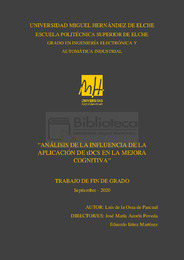Por favor, use este identificador para citar o enlazar este ítem:
https://hdl.handle.net/11000/7853Registro completo de metadatos
| Campo DC | Valor | Lengua/Idioma |
|---|---|---|
| dc.contributor.advisor | Azorín Poveda, José María | - |
| dc.contributor.advisor | Iáñez, Eduardo | - |
| dc.contributor.author | de la Ossa, Luis | - |
| dc.contributor.other | Departamentos de la UMH::Ingeniería de Sistemas y Automática | es |
| dc.date.accessioned | 2021-05-24T17:25:20Z | - |
| dc.date.available | 2021-05-24T17:25:20Z | - |
| dc.date.created | 2020-09-11 | - |
| dc.date.issued | 2020-09-11 | - |
| dc.identifier.uri | http://hdl.handle.net/11000/7853 | - |
| dc.description.abstract | En el presente trabajo se ha realizado un análisis en profundidad de un total de 18 investigaciones sobre el efecto de la estimulación tDCS en diferentes funciones cognitivas. En concreto, las investigaciones escogidas se centraban en la memoria de trabajo, la memoria declarativa, la atención visual, la habilidad para el disparo, la capacidad para realizar multitarea y la sensibilidad perceptual. Para ello, una vez estudiada cada investigación se realizaba una simulación de la estimulación empleada en la misma, mediante el programa SimNIBS. Esto permitía realizar un análisis posterior sobre las zonas estimuladas, y la densidad de corriente que circulaba por cada una de ellas. A continuación, en un capítulo de discusión, se realizó una exposición crítica de todo aquello comentado en las investigaciones y las simulaciones realizadas, intentando relacionar los resultados de todas ellas para poder llegar a conclusiones que pudieran ser generalizadas a la técnica de la tDCS, con el objetivo de arrojar luz sobre cuáles podrían ser los parámetros óptimos para la aplicación de la misma | es |
| dc.description.abstract | The purpose of this work was to investigate the effect of tDCS in diverse cognitive functions. To this end, a total of 18 different studies were examined. Specifically, this work aimed to study the mentioned effects on working memory, declarative memory, visual attention, shooting accuracy, multitasking and perceptual sensitivity. In order to do that, we used the software SimNIBS to create a simulation of every condition of stimulation applied on the different studies. With the results of these simulations, we were able to determine which cerebral structures were being stimulated and how much density of current was flowing through them. Employing this information and the conclusions of the studies, we conducted a critical analysis with the objective of determining which parameters were the more optimal in order to help in the design of future studies | es |
| dc.format | application/pdf | es |
| dc.format.extent | 88 | es |
| dc.language.iso | spa | es |
| dc.publisher | Universidad Miguel Hernández de Elche | es |
| dc.rights | info:eu-repo/semantics/openAccess | es |
| dc.subject | TDCS | es |
| dc.subject | mejora cognitiva | es |
| dc.subject | cerebro | es |
| dc.subject.other | CDU::6 - Ciencias aplicadas::62 - Ingeniería. Tecnología | es |
| dc.title | Análisis de la influencia de la aplicación de tDCS en la mejora cognitiva | es |
| dc.type | info:eu-repo/semantics/bachelorThesis | es |
| dc.type | info:eu-repo/semantics/bachelorThesis | es |
| dc.type | info:eu-repo/semantics/bachelorThesis | es |

Ver/Abrir:
TFG-de la Ossa de Pascual, Luis.pdf
3,73 MB
Adobe PDF
Compartir:
 La licencia se describe como: Atribución-NonComercial-NoDerivada 4.0 Internacional.
La licencia se describe como: Atribución-NonComercial-NoDerivada 4.0 Internacional.
.png)